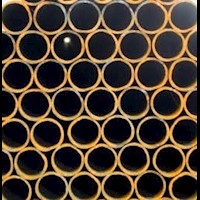Steel Round Tube and Pipe
Round Tubes and Pipes
Don't see what you're looking for?
Contact our friendly sales team for expert assistance in locating the right product for your needs.
Carbon Steel is a steel with carbon content up to 2.1% by weight. The definition of carbon steel from the American Iron & Steel Institute (AISI) states:
Steel is considered to be carbon steel when:
No minimum content is specified or required for chromium, cobalt, molybdenum, nickel, niobium, titanium, tungsten, vanadium or zirconium, or any other element to be added to obtain a desired alloying effect;
The specified minimum for copper does not exceed 0.40 percent;
Or the maximum content specified for any of the following elements does not exceed the percentages noted: manganese 1.65, silicon 0.60, copper 0.60.
The term "carbon steel" may also be used in reference to steel which is not stainless steel; in this use carbon steel may include alloy steels.
As the carbon percentage content rises, steel has the ability to become harder and stronger through heat treating; however, it becomes less ductile. Regardless of the heat treatment, a higher carbon content reduces weldability. In carbon steels, the higher carbon content lowers the melting point.
Contact our friendly sales team for expert assistance in locating the right product for your needs.
Carbon Steel is a steel with carbon content up to 2.1% by weight. The definition of carbon steel from the American Iron & Steel Institute (AISI) states:
Steel is considered to be carbon steel when:
No minimum content is specified or required for chromium, cobalt, molybdenum, nickel, niobium, titanium, tungsten, vanadium or zirconium, or any other element to be added to obtain a desired alloying effect;
The specified minimum for copper does not exceed 0.40 percent;
Or the maximum content specified for any of the following elements does not exceed the percentages noted: manganese 1.65, silicon 0.60, copper 0.60.
The term "carbon steel" may also be used in reference to steel which is not stainless steel; in this use carbon steel may include alloy steels.
As the carbon percentage content rises, steel has the ability to become harder and stronger through heat treating; however, it becomes less ductile. Regardless of the heat treatment, a higher carbon content reduces weldability. In carbon steels, the higher carbon content lowers the melting point.
Item # |
Description |
Form |
|---|---|---|
| CSP-250.080-A53 CSP-250.080-A53/Asset/steel-round-tube-and-pipe.jpg | N/A A53 Steel Pipe 2.500" Schedule 80 2.875" x 0.276" | Form N/A Pipe |
| CSP-500.080-500 CSP-500.080-500/Asset/steel-round-tube-and-pipe.jpg | N/A A500 Steel Pipe 5.000" Schedule 80 5.563" x 0.375" | Form N/A Pipe |
| CSP-800.080-500 CSP-800.080-500/Asset/steel-round-tube-and-pipe.jpg | N/A A500 Steel Pipe 8.000" Schedule 80 8.625" x 0.500" | Form N/A Pipe |

